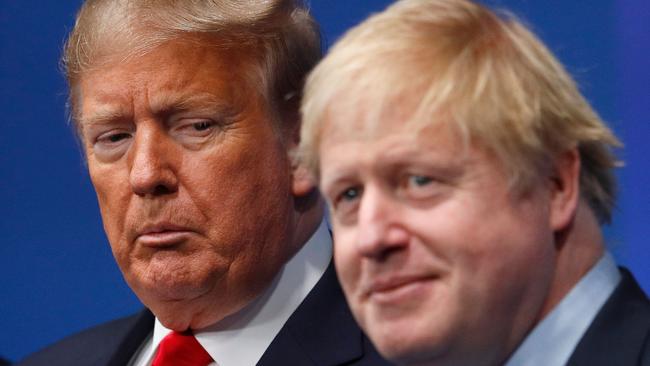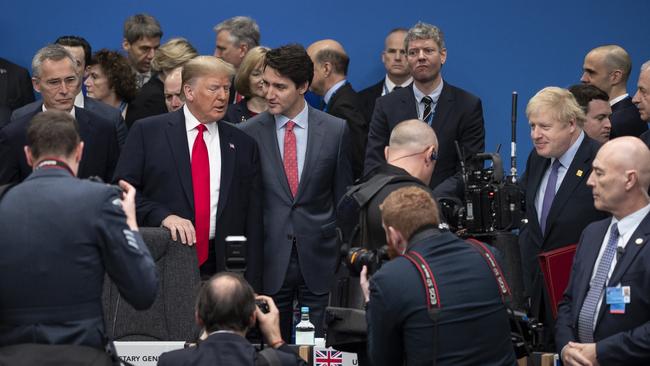Voters swing to the right, but can parties keep them?
A thumping Conservative victory in the UK lights a path to victory for Donald Trump next year, but a bigger challenge looms.

The victory of Boris Johnson and the Conservatives on December 12 was historic in its realignment of British politics and confirms the result of the Brexit plebiscite was not a one-off incident.
It also confirms the trend in many Western democracies of metropolitan communities strengthening their support for parties of the left that offer increasingly radical policies while regional areas and those communities with less formal education strongly swing in behind centre-right parties with clear agendas that support aspiration and national identity.
The result also suggests Donald Trump has a clear path to re-election on November 3 next year despite the soap operas that seem to dominate his presidency.
In recent discussions with Trump campaigners it is clear planning for his re-election is much more advanced and at a more sophisticated level than in any previous presidential campaign. But he has formidable strategic hurdles, many of his own making, to overcome.
In a presidential election it’s the electoral college that matters. In 2016 Trump was elected with 304 electoral college votes to Hillary Clinton’s 227. Clinton won 88 of the country’s 100 largest counties and won the popular vote by nearly three million votes. But, as in Britain and Australia, the story across the rest of the nation was different. Trump won 2649 counties to Clinton’s 503, according to Time magazine. If the three largest counties by population were removed from the count in 2016, Clinton would have lost the popular vote by 150,000 votes.
Next year the states of Florida, Michigan, Iowa, Pennsylvania, Wisconsin and North Carolina will be the key battlegrounds. In reality, the election probably will be decided in just 10 counties across those states, and none shares the typical demographics of New York or San Francisco. The Trump campaign has had campaign staff employed in 20 states, including these key battlegrounds, since June, far ahead of any other presidential campaign at this stage in the electoral cycle.
These campaign logistics may give Trump an early edge but the wider challenges he faces remain significant. The 2016 presidential campaign was the first in which a candidate, Trump, had an unfavourability rating greater than 50 per cent. Previously, Republican Barry Goldwater in 1964 held the record with an unfavourability rating at 47 per cent. What helped Trump in 2016 was that by the end of the campaign, Clinton had become the second most unfavourable candidate in history with her rating also over 50 per cent.

The challenge for the Trump campaign is that the President’s unfavourability has not improved during his term. In particular, women have a high unfavourability towards him driven primarily by his behaviour and style. But this is only part of the story. In a somewhat contradictory result, the research also finds that white women in key battleground states give Trump high approval for his management of the economy.
What this means is that for Trump to win, the campaign must be about the economy, not character. The challenge is whether he can remove the distractions and self-indulgences that have marked his term and allow the electorate to focus on his record and on key policy differences with the Democrats. Democrats also need to make the election about kitchen-table economics and the concerns facing average Americans outside the coastal cities. But it is not clear they will be able to do so.
The impeachment issue, driven by party activists with a fixated hatred of Trump, is driving the Democrats’ strategy and it is not clear this is helping the party at the ballot box. A recent poll in battleground states found 60 per cent of people opposed impeachment. Another national poll found 66 per cent of voters believe “impeachment matters more to the media than to me”.
In an era in which politics has become entertainment and political parties are losing the capacity to set and drive the agenda, Trump is perhaps the candidate for the times. He has the ability, by force of personality and his disregard for conventional boundaries, to set and command the political agenda like few other figures we have seen.
As a consequence, he has an overwhelming share of the non-paid media coverage of politics in the US, and that matters in an age where campaign messages are increasingly fragmented and voters are becoming more and more difficult to communicate with.
In Britain, Johnson achieved the biggest Conservative win in parliamentary seats since Margaret Thatcher in 1987. In doing so, the Conservatives increased their support across Britain by only 1.2 per cent of the vote. But in four seats a swing of more than 3 per cent was achieved and 15 seats had a swing of 2 per cent or more. All were in what previously was considered Labour heartland.
Post-election research in Britain showed the key swing demographic was older white men who backed Leave, used to support Labour and live in smaller towns across the north and the Midlands; not at all your typical or expected Tory voter. And as with Trump there is a clear difference in support between the sexes, with men giving the Conservatives a 19-point margin of support over Labour while with women the Conservative margin was in single digits at six points.
We are at a critical moment in the evolution of politics in Western democracies. The US, Britain and Australia each have governments unexpectedly elected by the realignment of traditional support. It is an open question as to whether those who have switched are, as Johnson mused after the election, merely lending their votes for the time being or have made a long-term committed change.
The inability of the left to comprehend and therefore respond to these developments is helping reinforce the trend with disastrous electoral consequences.
As Tony Blair’s former adviser Alastair Campbell pointed out on election night in Britain, if the newly elected parliament runs its full term it will be 50 years since anyone other than Blair has led Labour to victory.
In Australia, Labor has won an absolute majority only once in the 26 years since 1993 and that was in 2007 with Kevin “from Queensland” who claimed to be an “economic conservative”. In Germany, the Social Democrats, which as recently as 2005 provided the chancellor, are polling at 1 per cent.
This is certainly a statement about the state of parties of the left. But just as significantly it is a statement about the aspirational nature of electorates and their basic desire for a better life for themselves and families and their willingness to reject parties and policies that ignore them.
It is also a salient reminder that, in politics, parties must meet communities where they are at rather than tell them what they should do or believe. Ultimately electorates pay by results and it will be the track record in government of centre-right parties that will determine their political fate. The Trump record in this respect is encouraging and suggests that if he can focus the campaign on the essentials affecting people’s lives such as job security and economic growth he has a pathway to re-election.
Scott Morrison has shown a steady hand in dealing with economic and budgetary challenges and has rejected calls for kneejerk responses to a range of issues. The community is clearly comfortable with its decision on May 18 and is letting the government get on with its job and will assess its performance at the next election.
With a small majority in the House of Representatives, the Coalition is vulnerable at the next election. But the lessons of the recent election here, and those in the US and Britain, should remind Anthony Albanese that nothing is inevitable in politics.
The Prime Minister knows he must earn the support of the community at the next election and focus his policies on their needs and concerns. If Labor hopes to be more successful next time it must realign its policies to be more acceptable to Australians outside the inner capital cities. It is clear to everyone with a passing interest in politics that Labor cannot go to the next election advocating changes to negative gearing and dividend imputation, with no clear position on Adani and regional job creation and an ambivalence, if not outright hostility, to people of faith — just to mention the most prominent changes that need to occur. Labor argues it will not be pushed into hasty revisions of policy. This seems a convenient excuse to buy time while internal differences are resolved and a policy compromise on where to next is developed.
When clarity in policy is essential, Labor’s approach is leading to complexity and confusion. Johnson’s win in Britain suggests there remains an upside for the Coalition at the next election in once traditional Labor seats. The Opposition Leader needs to “go hard and go early” in reforming his party’s key policy positions before even more quiet Australians decide Labor has left them behind.
Brian Loughnane was Coalition campaign director in four national elections. He has just returned from the US and Britain.



To join the conversation, please log in. Don't have an account? Register
Join the conversation, you are commenting as Logout